急性髓细胞白血病的微小残留病检测陈苏宁
- 格式:pdf
- 大小:1.44 MB
- 文档页数:46
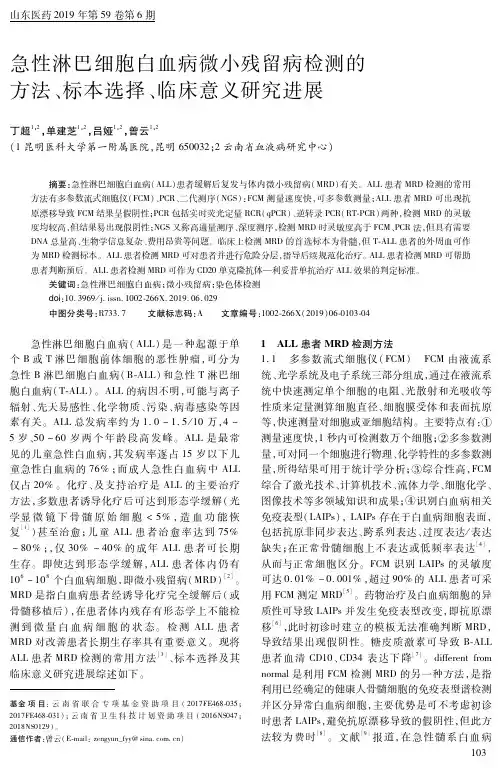
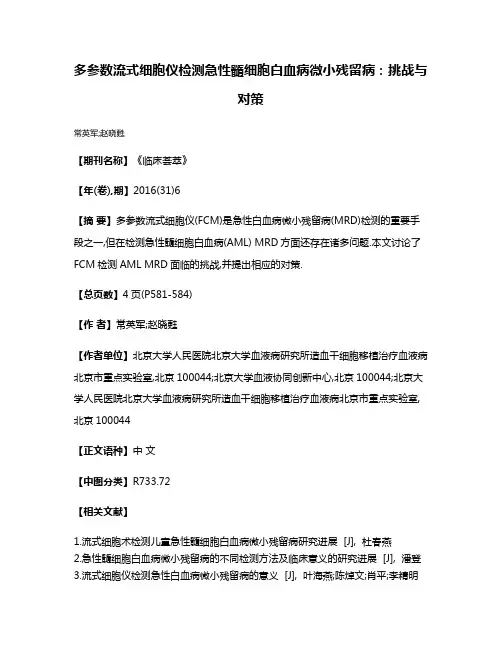
多参数流式细胞仪检测急性髓细胞白血病微小残留病:挑战与
对策
常英军;赵晓甦
【期刊名称】《临床荟萃》
【年(卷),期】2016(31)6
【摘要】多参数流式细胞仪(FCM)是急性白血病微小残留病(MRD)检测的重要手段之一,但在检测急性髓细胞白血病(AML) MRD方面还存在诸多问题.本文讨论了FCM检测AML MRD面临的挑战,并提出相应的对策.
【总页数】4页(P581-584)
【作者】常英军;赵晓甦
【作者单位】北京大学人民医院北京大学血液病研究所造血干细胞移植治疗血液病北京市重点实验室,北京100044;北京大学血液协同创新中心,北京100044;北京大学人民医院北京大学血液病研究所造血干细胞移植治疗血液病北京市重点实验室,北京100044
【正文语种】中文
【中图分类】R733.72
【相关文献】
1.流式细胞术检测儿童急性髓细胞白血病微小残留病研究进展 [J], 杜春燕
2.急性髓细胞白血病微小残留病的不同检测方法及临床意义的研究进展 [J], 潘登
3.流式细胞仪检测急性白血病微小残留病的意义 [J], 叶海燕;陈焯文;肖平;李精明
4.微小残留病指导的急性髓细胞白血病个体化治疗和干预策略 [J], 常英军; 李思琦; 魏辉
5.WT1基因在急性髓细胞性白血病微小残留病检测中的应用 [J], 李乾鹏;曹荣旋;张俊英;孙艳花;王宝宏;冉学红
因版权原因,仅展示原文概要,查看原文内容请购买。
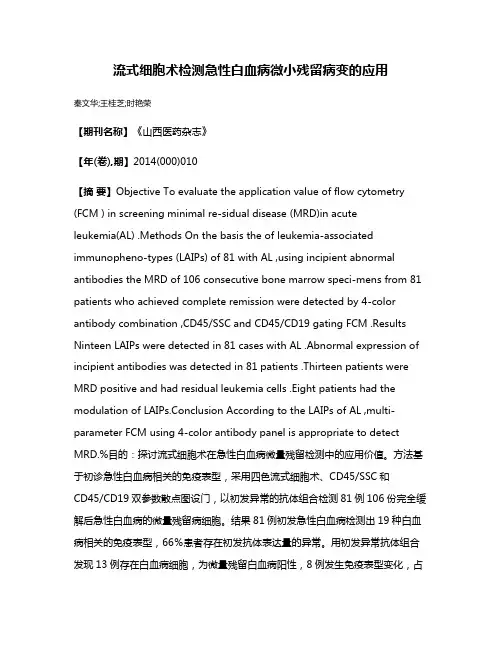
流式细胞术检测急性白血病微小残留病变的应用秦文华;王桂芝;时艳荣【期刊名称】《山西医药杂志》【年(卷),期】2014(000)010【摘要】Objective To evaluate the application value of flow cytometry (FCM ) in screening minimal re-sidual disease (MRD)in acuteleukemia(AL) .Methods On the basis the of leukemia-associated immunopheno-types (LAIPs) of 81 with AL ,using incipient abnormal antibodies the MRD of 106 consecutive bone marrow speci-mens from 81 patients who achieved complete remission were detected by 4-color antibody combination ,CD45/SSC and CD45/CD19 gating FCM .Results Ninteen LAIPs were detected in 81 cases with AL .Abnormal expression of incipient antibodies was detected in 81 patients .Thirteen patients were MRD positive and had residual leukemia cells .Eight patients had the modulation of LAIPs.Conclusion According to the LAIPs of AL ,multi-parameter FCM using 4-color antibody panel is appropriate to detect MRD.%目的:探讨流式细胞术在急性白血病微量残留检测中的应用价值。
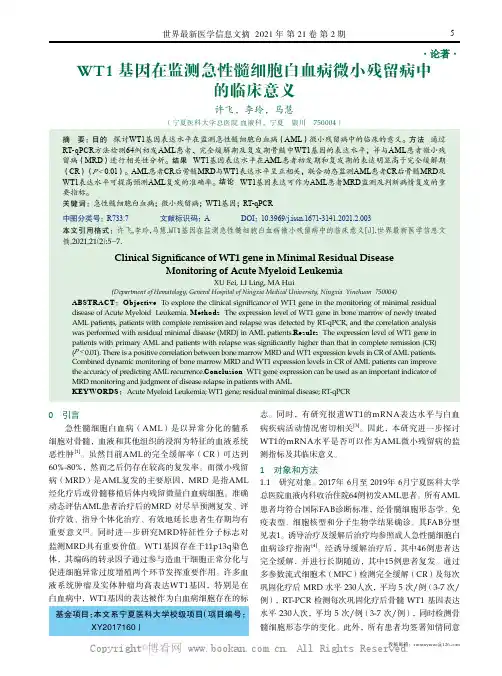
世界最新医学信息文摘 2021年 第21卷 第2期5投稿邮箱:zuixinyixue@·论著·WT1基因在监测急性髓细胞白血病微小残留病中的临床意义许飞,李玲,马慧(宁夏医科大学总医院 血液科,宁夏 银川 750004)0 引言急性髓细胞白血病(AML )是以异常分化的髓系细胞对骨髓,血液和其他组织的浸润为特征的血液系统恶性肿[1]。
虽然目前AML 的完全缓解率(CR )可达到60%-80%,然而之后仍存在较高的复发率。
而微小残留病(MRD )是AML 复发的主要原因,MRD 是指AML 经化疗后或骨髓移植后体内残留微量白血病细胞。
准确动态评估AML 患者治疗后的MRD 对尽早预测复发、评价疗效、指导个体化治疗、有效地延长患者生存期均有重要意义[2]。
同时进一步研究MRD 特征性分子标志对监测MRD 具有重要价值。
WT1基因存在于11p13q 染色体,其编码的转录因子通过参与造血干细胞正常分化与促进细胞异常过度增殖两个环节发挥重要作用。
许多血液系统肿瘤及实体肿瘤均高表达WT1基因,特别是在白血病中,WT1基因的表达被作为白血病细胞存在的标志。
同时,有研究报道WT1的mRNA 表达水平与白血病疾病活动情况密切相关[3]。
因此,本研究进一步探讨WT1的mRNA 水平是否可以作为AML 微小残留病的监测指标及其临床意义。
1 对象和方法1.1 研究对象。
2017年 6月至 2019年 6月宁夏医科大学总医院血液内科收治住院64例初发AML 患者。
所有AML 患者均符合国际FAB 诊断标准,经骨髓细胞形态学、免疫表型、细胞核型和分子生物学结果确诊。
其FAB 分型见表1。
诱导治疗及缓解后治疗均参照成人急性髓细胞白血病诊疗指南[4]。
经诱导缓解治疗后,其中46例患者达完全缓解,并进行长期随访,其中15例患者复发。
通过多参数流式细胞术(MFC )检测完全缓解(CR )及每次巩固化疗后 MRD 水平 230人次,平均 5 次/例(3-7 次/例),RT-PCR 检测每次巩固化疗后骨髓 WT1 基因表达水平 230人次,平均 5 次/例(3-7 次/例),同时检测骨髓细胞形态学的变化。

CD7抗原在急性髓系白血病微小残留病灶检测中的应用研究栾春来;孟君霞;何孜岩;张晓南;唐广;陈杰甫;武永强【摘要】Objective To study the expression of CD7 antigen in acute myeloid leukemia (AML) and the significance of CD7 in detection of AML minimal residual disease (MRD).Methods One hundred and eighty-six cases of newly diagnosed AML were collected from May of 2012 to June of 2015 in Anyang District Hospital, and immunophenotyping was performed by flow cytometry (FCM).The expression of CD7 antigen in bone marrow primitive cells was observed.For CD7+ AML patients with complete remission, a variety of other myeloid antibodies were combined with CD7 to detect the MRD.And for CD7-AML patients with complete remission, according to the initial immunophenotype, a variety of myeloid antibodies were combined to detec t the MRD.MRD≥1.0×10-4 was positive,MRD<1.0×10-4 was negative.All patients were followed up for 3~24 months, and MRD value, whether recurrence and recurrence time accrording to bone marrow were recorded.Results A total of 51 patients with CD7+ were detected in 186 patients with AML.Among the 33 patients with complete remission, 21 cases of bone marrow recurrence were detected in 26 cases of MRD positive patients using FCM,and 3 cases of bone marrow recurrence in 7 cases of negative patients.MRD positive recurrence rate was 63.6% in the CD7+ group. Among the 135 patients in the CD7-group, using FCM to track the MRD,90 cases were complete remission, and 20 cases of bone marrow recurrence were detected in the35 cases of MRD positive patients.17 cases were detected as bone marrow recurrence in 55 cases of MRD negative.In the MRD+ group, the recurrence rate was 22.2%.The relapse rate of CD7+ group was significantly higher than the corresponding group (P<0.05).Conclusion In the detection of MRD of CD7+ AML patients, CD7 antigen combined with other myeloid antigen can distinguish between normal cells and leukemia cells, and it can be used as as an important index for MRDdetection,provide the basis for adjustment of AML treatment strategies.%目的研究CD7抗原在急性髓系白血病(AML)中的表达及CD7在AML微小残留病灶(MRD)检测中的意义.方法选取安阳地区医院2012年5月至2015年6月收治的186例初发AML患者,应用流式细胞术(FCM)进行免疫表型分析,观察CD7在骨髓原始细胞中的表达情况.对于完全缓解的CD7+ AML患者,将其他多种髓系抗体与CD7构成组合,进行MRD检测;对于CD7-AML完全缓解患者,根据初发免疫表型进行多种髓系抗体组合,进行MRD检测.以MRD≥1.0×10-4者计为阳性,MRD<1.0×10-4计为阴性,跟踪随访3~24个月,记录MRD值、是否复发及骨髓确诊复发时间.结果 186例AML患者中检测出51例CD7+患者,对达完全缓解的33例患者,应用FCM进行MRD追踪检测,检测到26例MRD阳性患者中的21例骨髓复发,7例阴性患者中的3例骨髓复发.CD7+组MRD阳性复发率为63.6%.CD7-组135例,对达完全缓解的90例患者应用FCM进行MRD追踪,检测到35例MRD阳性患者中的20例复发,55例阴性患者中的17例骨髓复发,CD7-组MRD阳性复发率为22.2%.CD7+组MRD阳性患者复发率比CD7-组MRD阳性患者高,差异有统计学意义(P<0.05).结论在CD7+ AML患者MRD检测中,CD7抗原与其他髓系抗原组合能够很好区分正常细胞和白血病细胞.CD7抗原可以作为AML-MRD检测的重要指标,为调整AML治疗策略提供依据.【期刊名称】《河南医学研究》【年(卷),期】2017(026)011【总页数】4页(P1927-1930)【关键词】急性髓系白血病;微小残留病;CD7;流式细胞术【作者】栾春来;孟君霞;何孜岩;张晓南;唐广;陈杰甫;武永强【作者单位】濮阳市安阳地区医院血液一科河南安阳 455000;濮阳市安阳地区医院血液一科河南安阳 455000;濮阳市安阳地区医院血液一科河南安阳 455000;濮阳市安阳地区医院血液一科河南安阳 455000;濮阳市安阳地区医院血液一科河南安阳 455000;濮阳市安阳地区医院血液一科河南安阳 455000;濮阳市安阳地区医院血液一科河南安阳 455000【正文语种】中文【中图分类】R544.1急性髓系白血病(acute myeloid leukemia,AML)是一组具有不同形态学、免疫表型、细胞遗传学和分子生物学特征的异质性、克隆性造血干/祖细胞疾病。
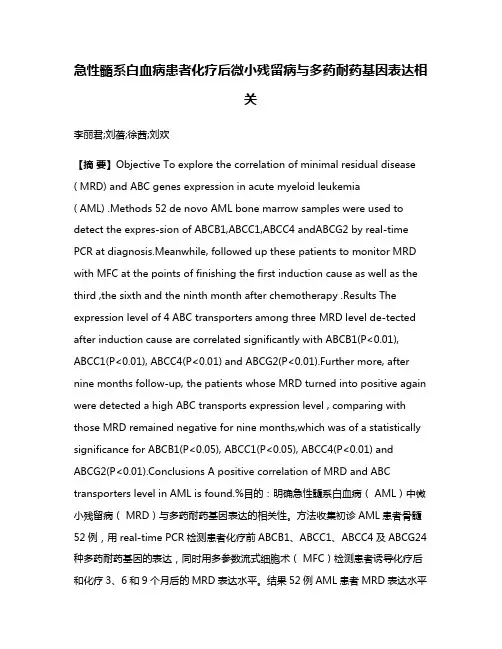
急性髓系白血病患者化疗后微小残留病与多药耐药基因表达相关李丽君;刘蓓;徐茜;刘欢【摘要】Objective To explore the correlation of minimal residual disease ( MRD) and ABC genes expression in acute myeloid leukemia( AML) .Methods 52 de novo AML bone marrow samples were used to detect the expres-sion of ABCB1,ABCC1,ABCC4 andABCG2 by real-time PCR at diagnosis.Meanwhile, followed up these patients to monitor MRD with MFC at the points of finishing the first induction cause as well as the third ,the sixth and the ninth month after chemotherapy .Results The expression level of 4 ABC transporters among three MRD level de-tected after induction cause are correlated significantly with ABCB1(P<0.01), ABCC1(P<0.01), ABCC4(P<0.01) and ABCG2(P<0.01).Further more, after nine months follow-up, the patients whose MRD turned into positive again were detected a high ABC transports expression level , comparing with those MRD remained negative for nine months,which was of a statistically significance for ABCB1(P<0.05), ABCC1(P<0.05), ABCC4(P<0.01) and ABCG2(P<0.01).Conclusions A positive correlation of MRD and ABC transporters level in AML is found.%目的:明确急性髓系白血病( AML)中微小残留病( MRD)与多药耐药基因表达的相关性。

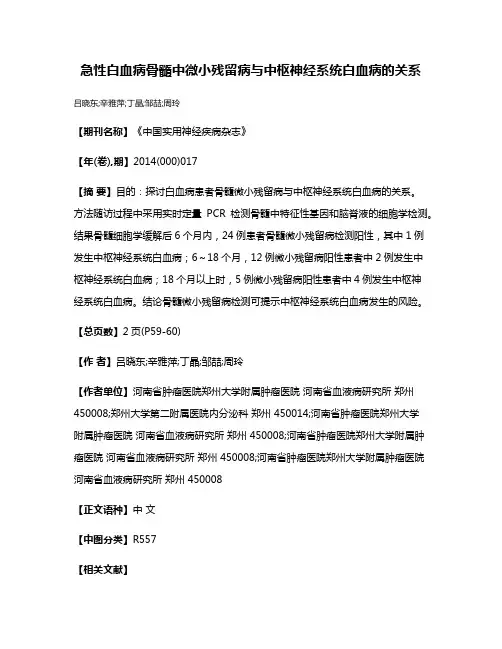
急性白血病骨髓中微小残留病与中枢神经系统白血病的关系吕晓东;辛雅萍;丁晶;邹喆;周玲【期刊名称】《中国实用神经疾病杂志》【年(卷),期】2014(000)017【摘要】目的:探讨白血病患者骨髓微小残留病与中枢神经系统白血病的关系。
方法随访过程中采用实时定量PCR检测骨髓中特征性基因和脑脊液的细胞学检测。
结果骨髓细胞学缓解后6个月内,24例患者骨髓微小残留病检测阳性,其中1例发生中枢神经系统白血病;6~18个月,12例微小残留病阳性患者中2例发生中枢神经系统白血病;18个月以上时,5例微小残留病阳性患者中4例发生中枢神经系统白血病。
结论骨髓微小残留病检测可提示中枢神经系统白血病发生的风险。
【总页数】2页(P59-60)【作者】吕晓东;辛雅萍;丁晶;邹喆;周玲【作者单位】河南省肿瘤医院郑州大学附属肿瘤医院河南省血液病研究所郑州450008;郑州大学第二附属医院内分泌科郑州 450014;河南省肿瘤医院郑州大学附属肿瘤医院河南省血液病研究所郑州 450008;河南省肿瘤医院郑州大学附属肿瘤医院河南省血液病研究所郑州 450008;河南省肿瘤医院郑州大学附属肿瘤医院河南省血液病研究所郑州 450008【正文语种】中文【中图分类】R557【相关文献】1.血清多肽图技术在急性白血病微小残留病监测中的应用 [J], 崔久嵬;梁婷婷;宋伟;李薇;王冠军;王娜;张学敏2.AP-PCR DNA指纹图在小儿急性白血病微小残留病检测中的应用 [J], 王允鸿3.WT-1 mRNA定量分析在急性白血病移植后微小残留病监测中的意义 [J], 郝英婵;伍权;张爱梅;徐修才4.急性淋巴细胞白血病微小残留病与中枢神经系统白血病的关系 [J], 蔡清;王宁玲;张爱梅;翟志敏;李庆5.基于分子条形码标记的超深度二代测序技术在儿童急性白血病微小残留病检测中的应用 [J], 王明敏;肖剑文;雷小英;杨山因版权原因,仅展示原文概要,查看原文内容请购买。
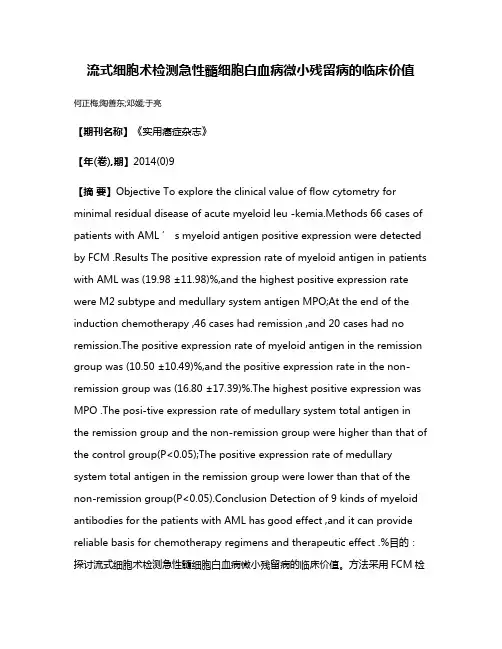
流式细胞术检测急性髓细胞白血病微小残留病的临床价值何正梅;陶善东;邓媛;于亮【期刊名称】《实用癌症杂志》【年(卷),期】2014(0)9【摘要】Objective To explore the clinical value of flow cytometry for minimal residual disease of acute myeloid leu -kemia.Methods 66 cases of patients with AML ’ s myeloid antigen positive expression were detected by FCM .Results The positive expression rate of myeloid antigen in patients with AML was (19.98 ±11.98)%,and the highest positive expression rate were M2 subtype and medullary system antigen MPO;At the end of the induction chemotherapy ,46 cases had remission ,and 20 cases had no remission.The positive expression rate of myeloid antigen in the remission group was (10.50 ±10.49)%,and the positive expression rate in the non-remission group was (16.80 ±17.39)%.The highest posi tive expression was MPO .The posi-tive expression rate of medullary system total antigen in the remission group and the non-remission group were higher than that of the control group(P<0.05);The positive expression rate of medullary system total antigen in the remission group were lower than that of the non-remission group(P<0.05).Conclusion Detection of 9 kinds of myeloid antibodies for the patients with AML has good effect ,and it can provide reliable basis for chemotherapy regimens and therapeutic effect .%目的:探讨流式细胞术检测急性髓细胞白血病微小残留病的临床价值。
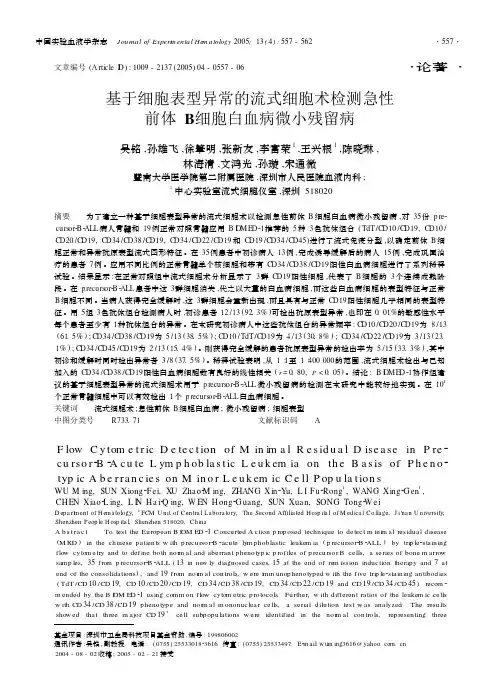
文章编号(A rticle I D ):1009-2137(2005)04-0557-06・论著・基于细胞表型异常的流式细胞术检测急性前体B 细胞白血病微小残留病吴铭,孙雄飞,徐肇明,张新友,李富荣1,王兴根1,陈晓琳,林海清,文鸿光,孙璇,宋通微暨南大学医学院第二附属医院,深圳市人民医院血液内科;1中心实验室流式细胞仪室,深圳518020摘要 为了建立一种基于细胞表型异常的流式细胞术以检测急性前体B 细胞白血病微小残留病,对35份p re 2curs or 2B 2ALL 病人骨髓和19例正常对照骨髓应用B I O M E D 21推荐的5种3色抗体组合(TdT/CD10/C D19,CD10/CD20/C D19,CD34/C D38/CD19,C D34/CD22/C D19和CD19/CD34/CD45)进行了流式免疫分型,以确定前体B 细胞正常和异常抗原表型流式图形特征。
在35例患者中初诊病人13例,完成诱导缓解后的病人15例,完成巩固治疗的患者7例。
应用不同比例的正常骨髓单个核细胞和带有CD34/C D38/CD19阳性白血病细胞进行了系列稀释试验。
结果显示:在正常对照组中流式细胞术分析显示了3群CD19阳性细胞,代表了B 细胞的3个连续成熟阶段。
在p recurs or 2B 2ALL 患者中这3群细胞消失,代之以大量的白血病细胞,而这些白血病细胞的表型特征与正常B 细胞不同。
当病人获得完全缓解时,这3群细胞会重新出现,而且具有与正常CD19阳性细胞几乎相同的表型特征。
用5组3色抗体组合检测病人时,初诊患者12/13(92.3%)可检出抗原表型异常,也即在0.01%的敏感性水平每个患者至少有1种抗体组合的异常。
在本研究初诊病人中这些抗体组合的异常频率:CD10/C D20/CD19为8/13(61.5%);CD34/C D38/CD19为5/13(38.5%);CD10/TdT/C D19为4/13(30.8%);C D34/CD22/C D19为3/13(23.1%);CD34/C D45/CD19为2/13(15.4%)。
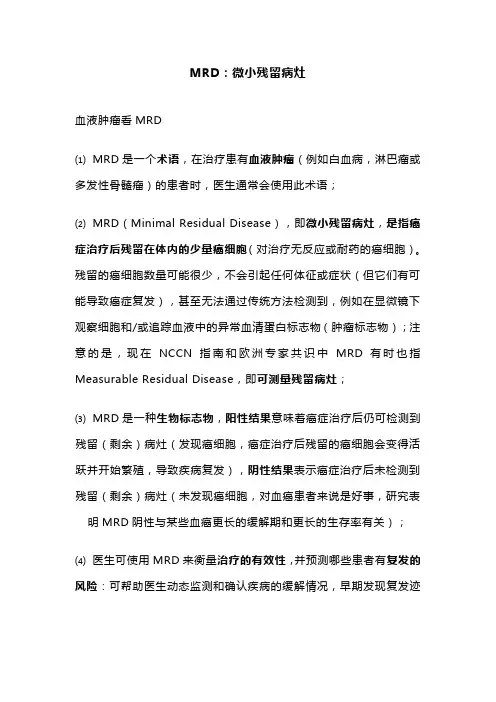
MRD:微小残留病灶血液肿瘤看MRD⑴MRD是一个术语,在治疗患有血液肿瘤(例如白血病,淋巴瘤或多发性骨髓瘤)的患者时,医生通常会使用此术语;⑵MRD(Minimal Residual Disease),即微小残留病灶,是指癌症治疗后残留在体内的少量癌细胞(对治疗无反应或耐药的癌细胞)。
残留的癌细胞数量可能很少,不会引起任何体征或症状(但它们有可能导致癌症复发),甚至无法通过传统方法检测到,例如在显微镜下观察细胞和/或追踪血液中的异常血清蛋白标志物(肿瘤标志物);注意的是,现在NCCN指南和欧洲专家共识中MRD有时也指Measurable Residual Disease,即可测量残留病灶;⑶MRD是一种生物标志物,阳性结果意味着癌症治疗后仍可检测到残留(剩余)病灶(发现癌细胞,癌症治疗后残留的癌细胞会变得活跃并开始繁殖,导致疾病复发),阴性结果表示癌症治疗后未检测到残留(剩余)病灶(未发现癌细胞,对血癌患者来说是好事,研究表明MRD阴性与某些血癌更长的缓解期和更长的生存率有关);⑷医生可使用MRD来衡量治疗的有效性,并预测哪些患者有复发的风险:可帮助医生动态监测和确认疾病的缓解情况,早期发现复发迹象,并尽早开始治疗;可告诉医生初始治疗效果如何,如果标准治疗方案效果不佳,医生会更改治疗方案,以更有效地获得疾病缓解;⑸何时检测MRD?何时检测MRD有不同的标准,应根据患者疾病的特定因素来决定。
患者可以在联合治疗的最后一个周期后进行检测,可以在骨髓移植后进行检测,可以在治疗期间进行检测确定缓解深度,可以在一年的维持治疗后进行检测,也可以在治疗结束后定期进行检测或在其他特定时间进行检测;⑹MRD检测样本?为了检测MRD,医生通常使用血液样本(静脉)或骨髓样本(抽吸);⑺MRD检测技术?MRD检测应使用高灵敏度的检测方法,如此才能更有效地在众多健康细胞中发现少量癌细胞。
最广泛使用的检测方法是:1)流式细胞术(FC,通过检测细胞表面是否存在某些蛋白质标记物来评估某个细胞的技术;为了得到可靠的结果,需要新鲜的骨髓抽吸样本,然后使用特殊的抗体处理,这种抗体只粘附在带有特定蛋白的细胞上,该检测方法可以在10万个骨髓细胞中发现一个癌细胞,检测结果一天内可以得到);2)聚合酶链式反应(PCR,可以根据其特有的遗传变异,如突变或染色体变异识别恶性肿瘤细胞;PCR 本质上是增加或放大少量的特定DNA或RNA片段,使它们更容易检测和计数,因此即使癌细胞数量非常少,也能通过PCR检测出基因异常,该检测方法可以在骨髓或血液样本的10万-100万个正常细胞中识别出一个癌细胞,检测结果可能需要几天或几周);3)二代测序(NGS,可以快速检测DNA或RNA片段;NGS可以检测从骨髓抽吸样本中提取的DNA突变和其他遗传变异,该检测方法可以在100万个骨髓细胞中检测出一个癌细胞,检测结果一周内可以得到;2018年美国FDA“批准”了一款名为clonoSEQ的检测,基于NGS方法,检测急性淋巴细胞白血病(ALL)和骨髓瘤中的MRD(特异性基因组重排));实体肿瘤看MRD⑻如上所述,MRD是血液肿瘤临床标准实践的一部分。
DNA启动子区甲基化状态改变在急性白血病微小残留病检测中的临床意义的开题报告一、研究背景与意义白血病是一种严重威胁人类健康的疾病,虽然目前已经有很多有效的治疗手段,但是由于白血病的高度异质性,治疗效果仍然存在很大的差异。
因此,如何准确评估治疗效果,预测疾病复发和预后成为了当前白血病治疗面临的严峻问题之一。
在治疗后的检测中,急性白血病微小残留病(minimal residual disease,MRD)的检测越来越成为重要的参考指标。
在MRD检测中,当前较为常用的方法是基于PCR扩增的技术。
然而,这种技术的局限在于需要有特异性的引物,如果突变了,就会导致引物无效。
对于这种情况,我们可以考虑使用DNA启动子区甲基化状态改变的方法。
DNA启动子区甲基化可以影响基因的表达,因此可以考虑将其作为潜在白血病细胞的标志物。
二、研究内容与方法1. 研究内容本文研究的主要内容是DNA启动子区甲基化状态在急性白血病MRD 检测中的临床意义。
在具体研究中,我们将对急性白血病患者的DNA样本进行甲基化测序,从中筛选出一些特异性甲基化状态改变的基因或者序列,以此作为MRD检测的潜在标志物。
同时,我们还会进行临床样本的实证研究,检测这些标志物在基因组水平上的效能,并与PCR扩增的结果进行比较。
2. 研究方法本研究所选用的方法主要包括:(1)甲基化测序:利用高通量测序技术对急性白血病患者的DNA样本进行甲基化测序,以此找到特异性甲基化状态改变的基因或者序列。
(2)临床样本实证研究:将筛选出来的标志物进行PCR扩增,并对临床样本进行检测,以此评估其在MRD检测中的效能及特异性。
(3)数据分析:对所得数据进行统计学分析和生物信息学分析,并比较与其他常用方法的效能和差异。
三、预期成果与意义本研究将探讨DNA启动子区甲基化状态在急性白血病MRD检测中的潜在应用价值,为MRD检测提供新的思路和方法,也有望从基础研究层面上探讨白血病发病机制。
儿童急性淋巴细胞白血病微小残留病的流式细胞术检测分析陈彦明;戴凤燕【期刊名称】《中国当代医药》【年(卷),期】2014(21)4【摘要】目的探讨流式细胞术检测微小残留病(MRD)在儿童急性淋巴细胞白血病(ALL)治疗中的临床价值.方法用多种四色荧光抗体组合检测50例正常儿童骨髓,据此建立双参数点图分析模型,500例ALL初发患儿行流式细胞分析,选出异于正常骨髓细胞免疫表型组合来检测MRD,根据确定好的免疫表型组合对105例患儿诱导治疗结束及后续治疗中的骨髓标本行MRD监测,同步行细胞形态学检测和PCR检测.结果流式细胞术检出462例有效MRD免疫表型组合,PCR检出142例判断MRD的融合基因或IgH/T淋巴细胞受体基因重排;细胞形态学对诱导治疗后的患儿的MRD阳性检出率为66.67%.流式细胞术的MRD阳性检出率为91.43%.结论流式细胞术能对ALL患儿治疗期间的MRD作出准确评估,具有较好的覆盖面和敏感性,值得临床应用.【总页数】3页(P171-172,175)【作者】陈彦明;戴凤燕【作者单位】广东省湛江市妇幼保健院,广东湛江524038;广东省湛江市第二人民医院,广东湛江524000【正文语种】中文【中图分类】R733.7【相关文献】1.儿童急性淋巴细胞白血病微小残留病的RQ-PCR检测分析 [J], 刘志强;柯江维;乐萍;段荣2.儿童急性淋巴细胞白血病微小残留病检测及其进展 [J], 徐翀;何妙侠;郑建明3.流式细胞术检测儿童急性淋巴细胞白血病微小残留病研究进展 [J], 景清;李戈4.以免疫球蛋白和T细胞受体基因重排为标志定量检测MLL基因重排儿童急性淋巴细胞白血病的微小残留病和预后关系 [J], 高超;李伟京;崔蕾;赵晓曦;刘曙光;吴敏媛;李志刚5.二代测序技术检测儿童急性淋巴细胞白血病微小残留病研究进展 [J], 李琴;麦惠容因版权原因,仅展示原文概要,查看原文内容请购买。
急性髓系白血病患者化疗后微小残留病与多药耐药基因表达相关李丽君;刘蓓;徐茜;刘欢【期刊名称】《基础医学与临床》【年(卷),期】2017(037)001【摘要】目的:明确急性髓系白血病( AML)中微小残留病( MRD)与多药耐药基因表达的相关性。
方法收集初诊AML患者骨髓52例,用real-time PCR检测患者化疗前ABCB1、ABCC1、ABCC4及ABCG24种多药耐药基因的表达,同时用多参数流式细胞术( MFC)检测患者诱导化疗后和化疗3、6和9个月后的MRD表达水平。
结果52例AML患者MRD表达水平与ABCB1(P<0.01)、ABCC1(P<0.01)、ABCC4(P<0.01)和ABCG2(P<0.01)的mRNA表达水平具有明显相关性。
持续监测9个月后,MRD再次转阳者ABC基因表达水平显著高于持续阴性者:ABCB1( P<0.05)、ABCC1(P<0.05)、ABCC4(P<0.01)和ABCG2(P<0.01)。
结论 MRD表达水平与多药耐药基因表达水平显著正相关。
【总页数】5页(P62-66)【作者】李丽君;刘蓓;徐茜;刘欢【作者单位】兰州大学第一医院血液科,甘肃兰州730000;兰州大学第一医院血液科,甘肃兰州730000;兰州大学第一医院血液科,甘肃兰州730000;兰州大学第一医院血液科,甘肃兰州730000【正文语种】中文【中图分类】R557【相关文献】1.中老年急性髓系白血病患者异基因造血干细胞移植前微小残留病检测意义的Meta分析 [J], 冯友繁;魏小芳;张启科2.中老年急性髓系白血病患者异基因造血干细胞移植前微小残留病检测意义的Meta分析 [J], 冯友繁;魏小芳;张启科;;;3.多参数流式细胞术对急性髓系白血病微小残留病变的监测及对患者复发率的影响[J], 王升;张琰;武永强4.肝脾硬度与急性髓系白血病微小残留病的相关性研究 [J], 王宁方;赵崇山;尤月明;王毅军;蔡卓纹;张东东;刘芳5.急性髓系白血病患者WT1基因表达水平及其在微小残留病灶监测中的临床意义[J], 宁可;王海峰;徐莉;李丽宁因版权原因,仅展示原文概要,查看原文内容请购买。